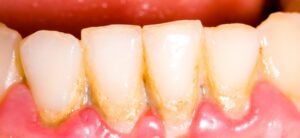Book a dental appointment
Plaque
Plaque is a biofilm consisting of microbial deposits, saliva and gingival crevicular fluid that begins forming on the teeth straight after cleaning of teeth. Plaque attaches to the teeth easily because in contrast to other body and oral cavity tissues, the teeth have a smooth and non-peeling surface that is constantly in a humid environment. Because there is a constant access to nutrients in the oral cavity, it is a good environment for bacteria to multiply very easily. The same happens in sewerage pipes where there is presence of water and constant inflow of nutrients.

Plaque formed on the teeth begins mineralising by precipitation of minerals from saliva and gingival crevicular fluid. It hardens into tartar. This happens already within two weeks if plaque is not removed from the teeth. Tartar is hard to remove from the teeth by brushing and the patient has to visit a dentist or hygienist to clean his or her teeth. If the biofilm spreads below the gum, a gingival pocket begins to form. The deeper tartar forms, the deeper the pocket around a tooth grows. While a normal gingival sulcus is 1–3 mm, >4 mm groove is already pathological. It has been scientifically proven that teeth with deep gingival pockets cannot be cleaned at home very efficiently and this facilitates further biofilm spreading.
Not all types of plaque cause progression of gingival inflammation to loss of attachment apparatus. People have specific species of bacteria in their oral cavities that in combination with mentioned factors may cause development of certain types of diseases.
- Diagnosis
- Objective of periodontitis treatment
- Non-surgical treatment of periodontitis
- Surgical treatment of periodontitis
- Surgical extension of a crown
- Mucogingival surgery
- Side effects of treatment
- When diagnosis and treatment are late
Read more about our other dental treatment services here.
Read more about oral health here.
